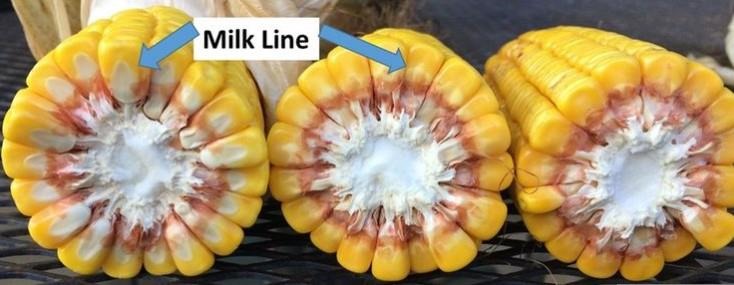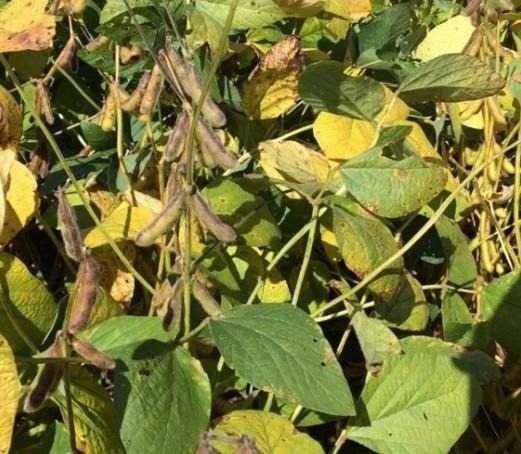By Lyndon Kelley

In corn, an irrigated field should be maintained at greater than 50% soil moisture until the milk line disappears and the black layer forms on corn kernel. Photo by Lyndon Kelley, MSU Extension.
Scattered rainfall over Indiana and Michigan has some producers contemplating the end of the irrigation season while others are watching the forecast hoping to avoid a few more weeks of irrigation. Unless the area is blessed with ample rainfall, producers are forced to make the decision when to stop irrigating. Turning off irrigation applications too soon could lower yields or reduce test weight. Applying irrigation water beyond the period that the crop needs it can waste water, time, energy and money.
Weather conditions in early September usually alleviate the need for late-season irrigation. The typical crop water use drops just as the average rainfall increases, negating the need for late season irrigation.
Late-season water use, termed evapotranspiration (ET), lowers significantly as crops near maturity. Soybean plants showing their first yellow pod will have an ET 0.10 inch per day for a day that reaches into the mid 80-degree Fahrenheit temperatures. Corn at dent stage will have an ET of 0.14 inch per day for a day that reaches the same temperature range. Daily temperatures that are 10 degrees higher or lower than the mid-80s will have ET rates that are 0.02 higher or lower than normal, respectively.
The goal of the soybean irrigator should be to maintain at least 50% of the available soil water holding capacity for soybeans until most pods yellow. Corn producers trying to maximize test weight during dry late-summer conditions should maintain at least 50% of the available soil water holding capacity until the crop reaches black layer. In most situations, minimal amounts of irrigation water are needed to achieve these goals. In the last few weeks of the season, soybeans will use less than 0.04 inch per day and corn less than .06 inch per day, allowing a half inch of rain or irrigation to last a week or more.
 Irrigation or rainfall is needed in soybean fields to keep at least 50% soil moisture until more than 50% of the plant’s leaves have yellowed. Photo by Lyndon Kelley, MSU Extension.
Irrigation or rainfall is needed in soybean fields to keep at least 50% soil moisture until more than 50% of the plant’s leaves have yellowed. Photo by Lyndon Kelley, MSU Extension.Both Purdue University and Michigan State University Extension services publish real-time evapotranspiration data on the web, showing how much water crops require each day at Purdue INClimate and Michigan State University Enviroweather service. A simple temperature-based water use graph is provided at Nebraska Irrigated and Rainfed Corn Yield and Acreage Trends from the University of Nebraska-Lincoln. It provides the daily water use for corn or soybeans at different growth stages.
If recent rains have refilled your water holding capacity, you may calculate if any more water is needed. As corn reaches the milk line stages of development and full dent, water use drops dramatically. In typical early September weather, full dent corn will use 1 inch of water per week and will drop to 0.8 inch the following week. The week before expected black layer, water use is predicted to be 0.5 inch per week. Our most common irrigated soils hold about 5 inches of water. We want to maintain soil at 50% of plant available water or higher. If rains fill the soil root zone at the time your corn crop reaches dent stage, the 2.5 inches of plant available water is greater than the 50% of water holding capacity and will be more than enough to finish the crop.
One simple irrigation scheduling method used to aid in making late season application decisions is to monitor soil moisture. Knowing soil moisture levels allows producers to use up the available soil moisture as the crop reaches maturity without allowing crop stress. Soil moisture monitoring aids in avoiding unneeded irrigation applications near the end of the season, helping to lower input costs and conserve water.
If you have not invested in a soil moisture monitoring system yet, there are ways to make crude estimates. For example, an in-field soil auger probe sample taken from 12 inches below the soil surface on a sandy loam soil should have enough soil moisture present that you can form a loose ball in your hand. Soils that form a tight ball show an even higher soil moisture level, which should be able to carry a crop for a few extra days.
Cover crop establishment may require an additional 0.5-inch application right after seeding if rainfall is not predicted. By late summer, a corn or soybean crop has developed an extensive root system down to 3 feet or more to draw water from. Newly-seeded cover crops are dependent on the moisture in the top inches of the soil and are dependent on rainfall or irrigation to germinate. With average energy costs for irrigation water under $4 per acre-inch of water applied, a $2 investment in a 0.5-inch irrigation application is a low-cost jumpstart for the cover crop.
Source : msu.edu